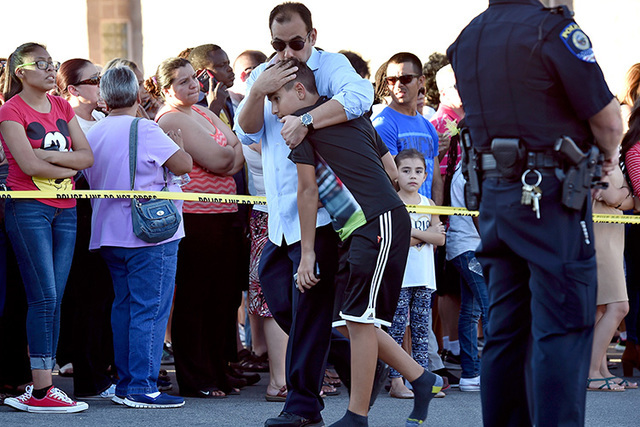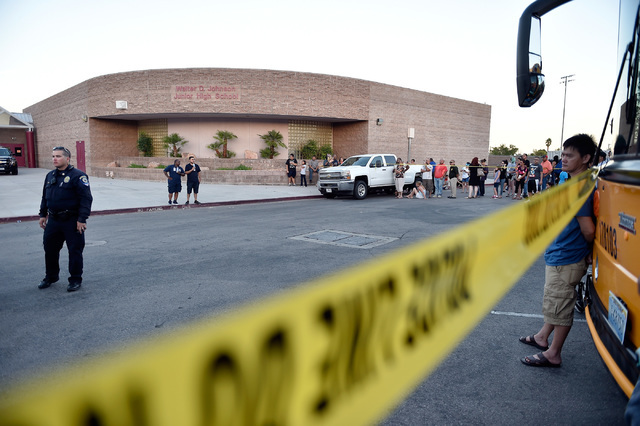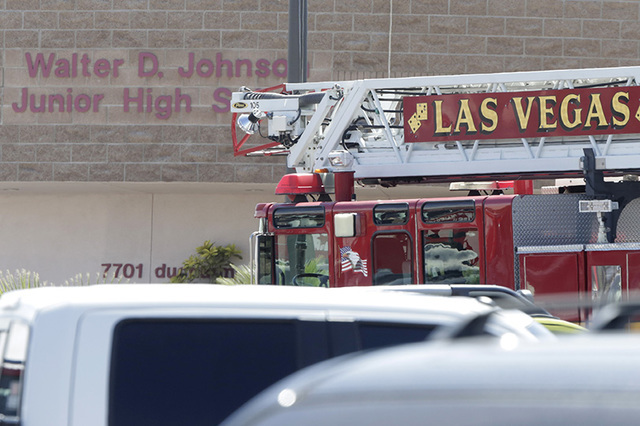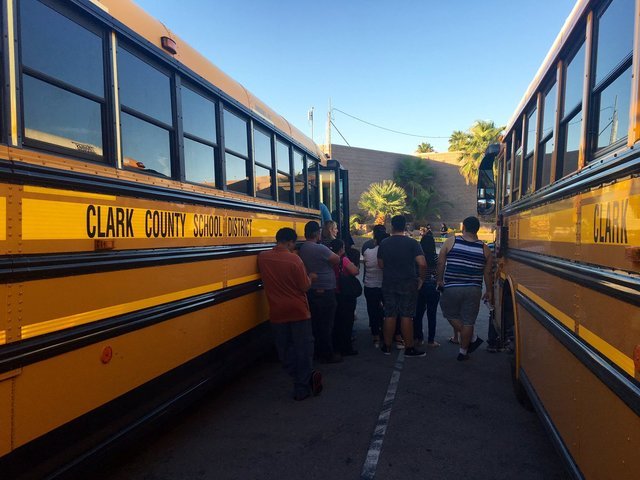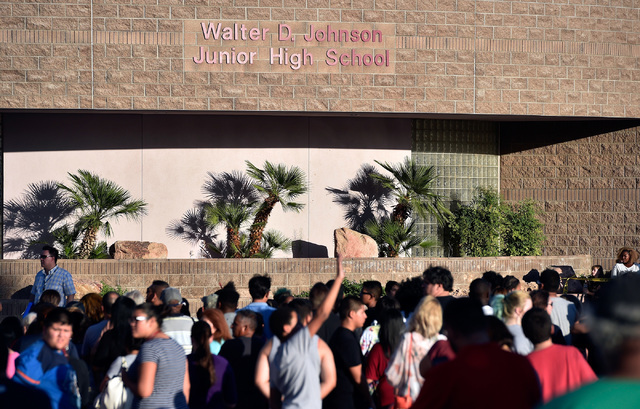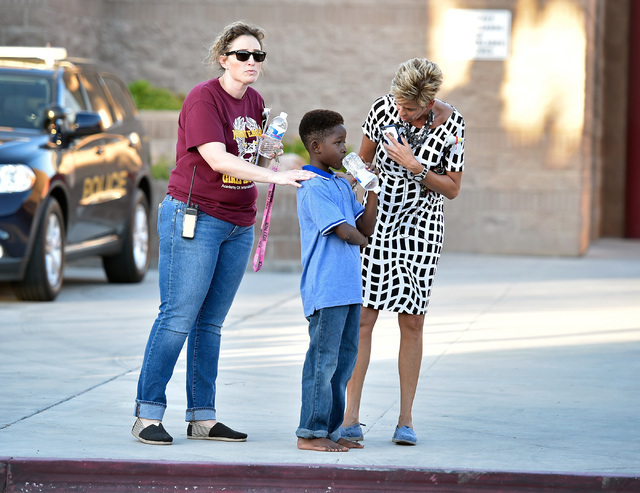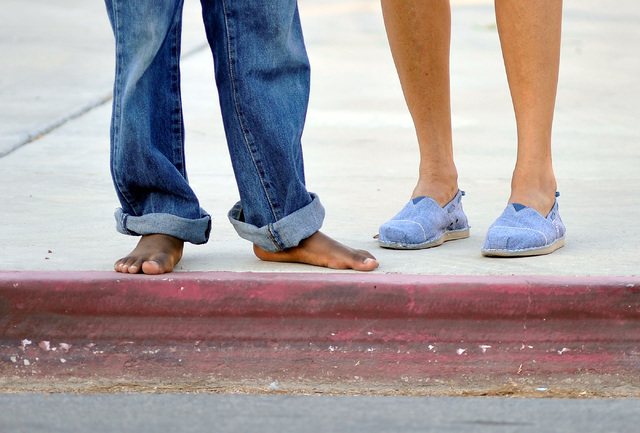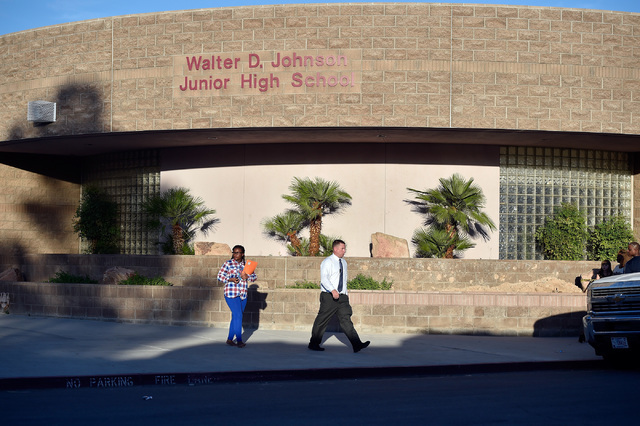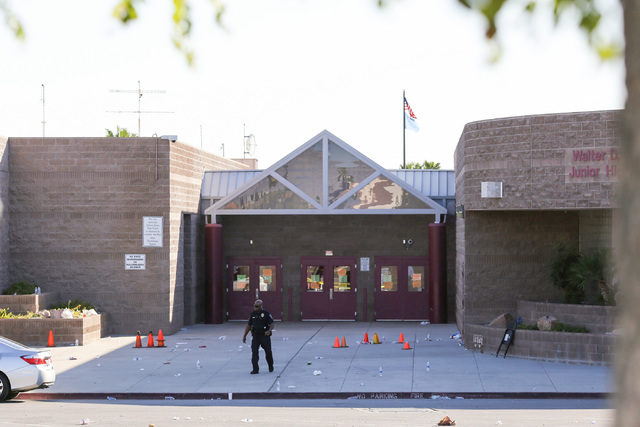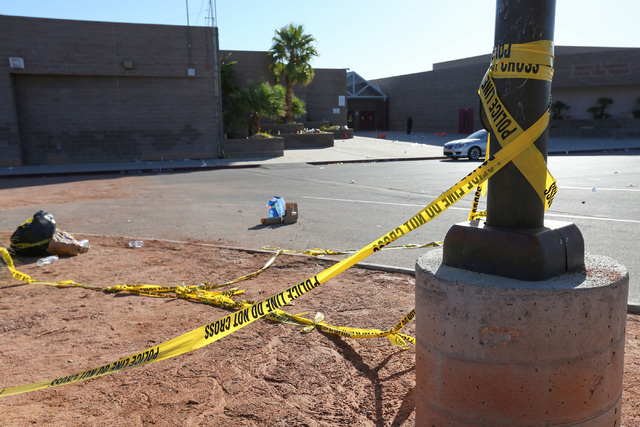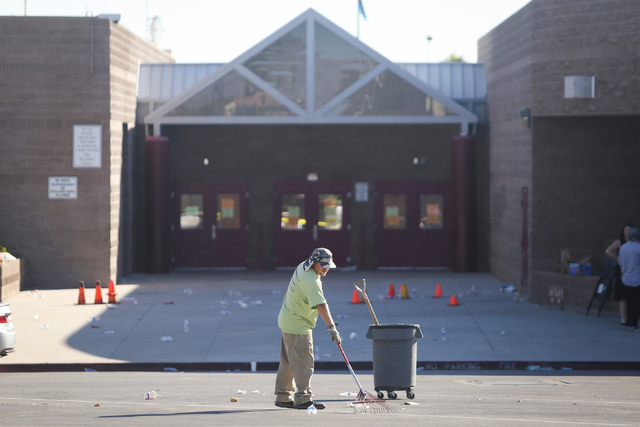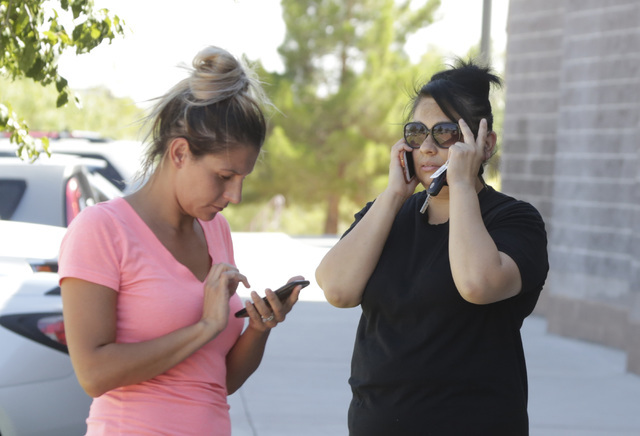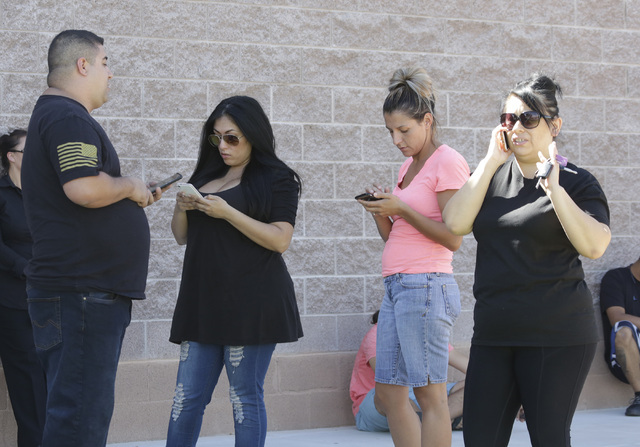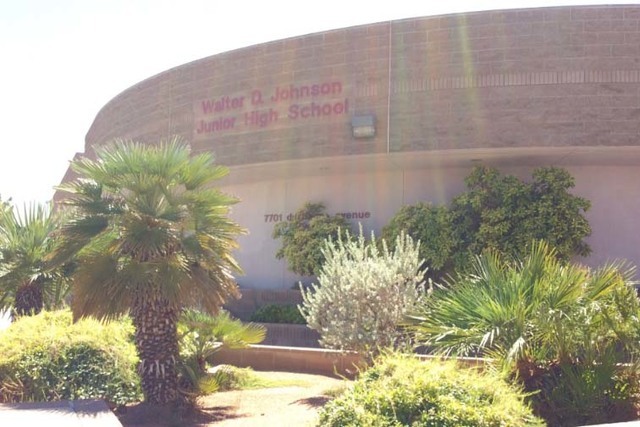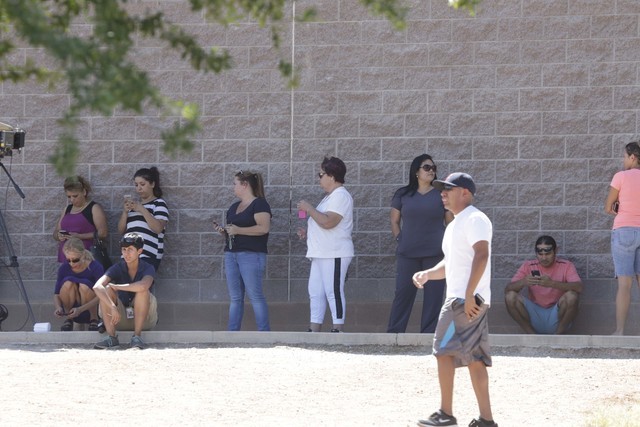Mercury contamination screenings completed at Las Vegas junior high school
A Las Vegas junior high school will remain closed Thursday following a lockdown that began Wednesday afternoon and lasted into the next morning as anxious parents waited for their sons and daughters to be screened and cleared from a mercury contamination on campus.
At 3:30 a.m., there was still about 50 students who still needed to be cleared of any contamination. By 5 a.m. all the students apparently had been screened and reunited with their parents.
The substance was discovered about noon in the gymnasium at Johnson Junior High School, Clark County School District police Capt. Ken Young said. The school is at 7701 Ducharme Ave., near Buffalo and Alta drives.
“We believe the mercury was brought onto campus by a student,” according to a message sent to parents. “According to EPA guidelines, all students must be tested before they can go home.”
As of about 8 p.m., several hundred students were estimated to be inside the school still waiting to be screened. As they were cleared, students were released in small groups of five or fewer.
School district spokeswoman Melinda Malone said there are no “immediate medical issues,” and officials are “just taking precautionary measures.” Officials do not know when the mercury first arrived on campus, she said.
“Right now our priority is safety and making sure we can get the kids home safely,” Malone said.
She did not have information about the test, which she described as a screening for everyone, including all children and adults, on campus.
Young said the Las Vegas Fire Department and a hazmat team responded to the scene. The Environmental Protection Agency also was asked to respond.
“We’re letting the EPA take the lead as far as people being screened,” Malone said.
Las Vegas Fire Department spokesman Tim Szymanski tweeted Wednesday afternoon that students were “being screened by EPA” and the department’s hazmat team. Szymanski said no injuries were reported.
Young, public information officer for CCSD police, said he could not confirm how many EPA agents were involved in the screening, but another CCSD police officer said there were three.
Szymanski later said the group of children first exposed to the substance were isolated from the rest of the school; school Principal George Anas came to investigate the substance when it was first discovered and was also exposed. Szymanski said he stayed with the children during the lockdown.
According to the message sent to parents, “No one is in immediate medical danger, the goal is to contain exposure.”
Szymanski reiterated that the goal was to prevent the spread of the contaminant, which he said could be carried on the soles of shoes.
“They did everything they were supposed to,” Szymanski said of the handling of the incident. “They did an excellent job.”
According to the statement, the EPA is collecting student and staff members’ shoes and backpacks; the “intent is to return students’ belongings to them at a later time.” Children were asked to write down the contents of their backpacks on pieces of paper.
The school district was providing food for students, the district told parents in an automated message.
Seven hours after her school was placed on lockdown for mercury contamination, seventh-grader Cayla Hunt walked into the crowd of anxious parents gathered outside her school and hugged her mother.
It was 7 p.m. The sun was setting, and she was without her socks, shoes and her backpack. She said she ate only a honeybun, crackers and drank water and juice about an hour before being released.
“I would have liked a little more information — to hear what’s really going on,” said her mother, Lucretia Hunt. “To hear that your daughter’s been in the same classroom since a little before noon, and you don’t get them until a little after 7, it’s overwhelming. I would have preferred a phone call from a teacher or the principal.”
Lucretia Hunt said she received only automated calls from the school.
Around 6:30 p.m. a police officer said there were still 900 students, in student body of 1,245, waiting to be a screened for mercury. By 8 p.m., well after the sun went down, the crowd of parents was still large, with some opting to bring lawn chairs as if attending a baseball game.
Like Hunt, parent Karina Aquino, who was waiting outside the school since 2 p.m., also was hoping for more updates.
“I’ve been very anxious,” she said around 6 p.m. “There have been so many mixed stories about what happened.”
When Aquino first arrived at the school, she was told the process would be about three hours. She said she saw several parents leave because they were told they would receive a phone call when their child was ready to be picked up. Aquino, however, didn’t want to risk leaving as her phone battery was dead.
Throughout the late afternoon and evening, school representatives used a megaphone to announce students’ names to waiting parents.
Parent Emilia Marquez said she believes the school was handling the situation properly by keeping the students in their same classroom throughout the day to avoid potential chaos.
“All the kids are just hungry and they’re wanting to leave,” Marquez said. “Hopefully this will just have been a huge scare and no one will have lasting consequences.”
Around 8:30 p.m., Young said he could not confirm how many students were still inside the school, nor how long the mercury has been in the school. However, a trailer was brought to the front to illuminate the area and to expedite the process.
Around that time, tempers started to flare, with one mother screaming, “Release my son now. I will not wait any longer!”
Each time the name of a student was announced over the muffled loudspeaker, parents near the source would shout the name, and people in the crowd would repeat it so those farther away could hear.
Parents said that a couple of phones were taken from students, but it was unclear whether it was related to potential contamination.
Just before midnight, Malone later sent out an updated statement from the district.
“The Environmental Protection Agency is continuing the process of screening students, and has provided additional screening resources,,” it read in part.
It also thanked parents for their patience. “We know this has been a challenging day, and we are thankful for the cooperation of our students, staff, first responders and our community.”
Past midnight, two mothers commiserated quietly while sitting on chairs outside the school. Around them, hundreds of parents still waited to hear their sons’ and daughters’ names called, meaning they could finally go home.
Lori Barga said she fears the district might not be giving the parents the whole story. “I think it’s much worse. It’s not what they say,” she said.
Also, she said she was worried about how her 11-year-old daughter, Andrea, and others were holding up inside the school. “They have been in there since 8 o’clock this morning. Class was supposed to finish at 3:20 p.m. and now it’s past midnight,” Barga said. “I’m worried that they will be tired and hungry and stressed.”
The other mother said she hadn’t heard from her 12-year-old twin sixth graders, a boy and a girl. “I have no idea what’s going on with them, either one of them. I’m frustrated,” she said. “They’re going to come out when they come out, I can’t control that. I want to make sure I’m positive when they come out.”
A few minutes later, she got good news. Her son Brandon was ready to be released.
After coming out of the school, Brandon unrolled the bottom of his T-shirt where he had stashed his phone and handed it to his mom. “They sniffed me with a little thingamabob,” he told his mom about the mercury screening process.
“Are you hungry?” she asked. “For real food, yes, more than just ‘Elf’ crackers,” he said. “Want a hamburger, honey? “Yes please!” was his reply.
After devouring the burger, Brandon was full of energy and ran up and down a walkway outside the school. Then it was back to the waiting game, as he and his mom awaited his twin sister’s release.
Review-Journal writer Neal Morton contributed to this story. Contact Natalie Bruzda at nbruzda@reviewjournal.com or 702-477-3897. Find @NatalieBruzda on Twitter. Contact Christian Bertolaccini at cbertolaccini@reviewjournal.com and 702-383-0381. Follow @bertolaccinic on Twitter.
Effects of mercury exposure
Mercury is a liquid, metallic substance, which gives off vapors. When inhaled, mercury can be harmful to health, especially for young children. It's a naturally occurring element in soil, water and food, particularly in shellfish, according to Dr. Daliah Wachs, a Henderson family physician.
"We are exposed to it regularly, but extraneous exposure could be harmful," she said in an email.
"With children we watch out for confusion, muscle twitching, insomnia, headaches, tremors, attention deficit, mood disorders," Wachs said. "And this could happen if one breathes it in as with a spill.
"Higher levels can cause serious side effects as well: kidney, gastrointestinal, nervous system issues, muscle weakness, vision impairment."
A similar mercury incident occurred at an elementary school in Worcester, Massachusetts, on Sept. 21, 2010. A sixth-grade student brought mercury into the Grafton Street Elementary School in a pint jar and showed his friends and teacher. The jar was opened in the classroom and mercury was released from the jar — triggering a large environmental and public health response, according to information on the EPA's website.




